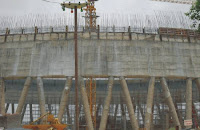What is Corrosion ?
Corrosion is the destructive attack to metal by a chemical or electrochemical reaction with its Environment. The terms corrosion and rusting are often used interchangeably. The term “rust” typically is applicable to ferrous materials, iron and steel. The most term to use is "corrosion" because it is inclusive of non-ferrous metals as well.
|
|
|
|
Passivity of Steel
Under certain conditions steel is passive, where the corrosion rate for the metal is relatively low. Iron is considered an active-passive metal and therefore steel behaves similarly. Passivity, defined simply, refers to a loss of chemical reactivity under certain conditions. Steel achieves this by having a passive film form along its surface.
Corrosion Factors
The cement paste in concrete is alkaline with a pH typically between 12 and 14. This paste surrounds reinforcing steel in concrete. Many researchers believe this alkaline environment facilitates the protective passive film around the steel. The passive film is not invulnerable, though. It can be damaged both chemically and mechanically.
Some examples of chemical damage are carbonation and chloride ingress. Carbonation is the result of the reaction of atmospheric carbon dioxide and hydroxides in the cement paste. Through this reaction carbonates and water are formed. The carbonates that form from this reaction consume the hydroxides present and therefore can lower the pH of the concrete below the value of 8.0. This action causes the steel to depassivate, leaving it susceptible to attack from corrosives. The likelihood of this occurrence is relative to the impermeability characteristics of the concrete. Adequate depths of the concrete cover for the bars and the use of good quality concrete mixes have, greatly reduced the concern for carbonation and its effect on corrosion. Ingress of chlorides, on the other hand, is far more destructive to the steel. These damaging chlorides are common in concrete environments. They are mainly present in marine environments and in deicing salts, however they can also be due to concrete admixtures containing chlorides and chloride contaminated cements, aggregates, and batch water.
Concrete is a permeable material and thus will absorb moisture. Different mixtures of concrete have different rates of moisture infusion. Along with moisture, oxygen and chlorides also diffuse through the uncracked concrete to the surface of the steel. A cathodic reaction is induced by the presence of these elements. The moisture and chlorides act as an electrolyte which facilitate the flow of ionic current. The chlorides initiate corrosion and oxygen fuels the reaction. It is reason able to expect that the lower the absorption and permeability of the concrete, the longer corrosion requires to initiate.
The two most common causes of reinforcement corrosion are (i) localized breakdown of the passive film on the steel by chloride ions and (ii) general breakdown of passivity by neutralization of the concrete, predominantly by reaction with atmospheric carbon dioxide. Sound concrete is an ideal environment for steel but the increased use of deicing salts and the increased concentration of carbon dioxide in modern environments principally due to industrial pollution, has resulted in corrosion of the rebar becoming the primary cause of failure of this material. The scale of this problem has reached alarming proportions in various parts of the world.
|
|
|
|
Corrosion Inhibitors
The rate of corrosion can also be reduced by using corrosion inhibitors. These inhibitors are chemical compounds that reduce the corrosion rate of metals existing in actively corrosive environments. This is accomplished by using corrosion inhibitors or reducing the rate of chloride ingress to the steel reinforcement. Corrosion inhibitor is a liquid added to concrete during the batching process. It chemically inhibits the corrosive action of chlorides on reinforcing steel and pre stressed strands in concrete. It also promotes strength development of the concrete while meeting ASTM C 494, Type C admixture.
|
|
|








